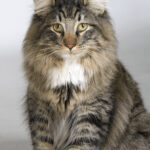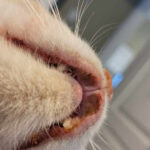If you’re a cat lover, you know the joy of a purring feline rubbing against your legs or settling in for a petting session. But have you ever wondered, “Where Do Cats Like To Be Pet?” It’s not always as straightforward as it seems. While many cats adore being stroked and will actively solicit your attention, others are more discerning about when, where, and how they are touched. Understanding your cat’s preferences is key to building a stronger bond and ensuring your interactions are positive and enjoyable for both of you.
Why Cats Enjoy Petting: Decoding Feline Affection
The reason behind a cat’s enjoyment of petting is multifaceted, rooted in their biology, communication, and emotional responses. Understanding these reasons can deepen your appreciation for this common interaction.
One primary reason cats enjoy being pet is linked to communication and scent marking. In the feline world, rubbing and nuzzling are crucial forms of social interaction. Cats use these behaviors to exchange scents and pheromones, creating a communal scent profile within their social group. When your cat rubs against you or your furniture, they are essentially marking you as part of their family. Petting, in this context, mimics these friendly interactions, reinforcing social bonds and communicating affection between cats and humans.
Furthermore, the act of being pet can trigger the release of oxytocin, often referred to as the “love hormone,” in both cats and humans. Kittens experience this hormone release through grooming and nurturing from their mothers, associating these actions with comfort and security. As adult cats, being pet by trusted humans can evoke similar feelings of comfort and pleasure due to the re-stimulation of this oxytocin response. This biological mechanism strengthens the positive association with petting and contributes to the affectionate bond between you and your cat.
:max_bytes(150000):strip_icc():format(webp)/why-cats-like-being-pet-5191232-hero-2695579273944463987600430950006.jpg)
Of course, the simple answer is also that petting often feels good to cats! The gentle stroking sensation can be soothing and pleasurable. However, it’s crucial to remember that every cat is an individual. Just as some people enjoy hugs more than others, cats have varying preferences. A cat’s history, personality, and current mood all play a role in whether they welcome petting at any given moment. Some cats might dislike petting due to past negative experiences, fear, pain, or simply a lack of early socialization to human touch. Building trust and understanding your cat’s individual cues is essential for enjoyable petting interactions.
Decoding Your Cat’s Petting Preferences: A Guide to Happy Strokes
Knowing how to approach and pet a cat is just as important as knowing where they like to be pet. Rushing in without observing their body language can lead to unwanted reactions. Here’s a step-by-step guide to ensure positive petting experiences:
1. Observe and Ask (If Necessary): Before reaching out, take a moment to observe the cat’s posture and demeanor. Are they relaxed and approachable, or tense and withdrawn? If it’s not your cat, always ask the owner for permission to pet them. They can provide valuable insights into the cat’s personality and any sensitive areas to avoid.
2. Let the Cat Initiate: Allow the cat to approach you on their own terms. Avoid chasing or cornering them, as this can be perceived as threatening. Instead, sit or stand calmly and extend a relaxed hand, palm down, towards the cat at their level.
3. The Sniff Test: Let the cat sniff your hand. This allows them to gather information about you through scent. They may rub against your hand or legs as a sign of greeting and acceptance.
4. Start with Gentle Facial Strokes: Begin petting gently on the areas most cats find agreeable: the sides of their face, the top of their head, and under the chin. These areas are often associated with social grooming and are rich in scent glands.
5. Follow Their Lead: Pay close attention to the cat’s body language as you pet them. A happy cat will often lean into your touch, purr, and may even nudge your hand to guide you to continue petting in a specific spot. They might roll onto their side, indicating relaxation and trust.
6. Recognize the “Red Flags”: Be mindful of signs that indicate the cat is becoming uncomfortable or overstimulated. These signs can include:
- Tension in their body: Stiffening, flinching, or trying to move away.
- Ear position: Flattened ears pressed against their head.
- Eye changes: Pupils dilating (becoming larger) or narrowed eyes.
- Tail signals: Swishing tail, puffed-up tail, or a rigid, tense tail.
- Vocalization: Hissing, growling, or high-pitched meowing (different from a contented purr).
- Sudden biting or scratching.
If you observe any of these signs, stop petting immediately and give the cat space. It’s always better to err on the side of caution and respect their boundaries.
The Sweet Spots: Where Cats Typically Love to Be Pet
While individual preferences vary, there are common areas where many cats enjoy being pet. These areas often correspond to where cats groom each other socially:
- Head: The top of the head and between the ears are generally well-received.
- Sides of the Face and Cheeks: Rubbing along the cheeks and sides of the face mimics social rubbing and scent marking.
- Under the Chin and Neck: Many cats enjoy gentle strokes under their chin and along their neck.
- Shoulders: The shoulder area is another spot where cats often appreciate petting.
- Back (to Tail Base): Stroking along the back, from the shoulders to the base of the tail, is often enjoyed, but pay attention to tail signals as you approach the tail area.
:max_bytes(150000):strip_icc():format(webp)/GettyImages-1288444328-d756b6369b9840e2896100139029d334.jpg)
Remember that even in these generally preferred areas, cats can become overstimulated. Overstimulation, sometimes referred to as petting-induced aggression, can occur when a cat becomes overwhelmed by touch. They might suddenly switch from enjoying petting to biting or scratching. This isn’t a sign of aggression, but rather their way of saying “enough.” Learning to recognize early signs of overstimulation is crucial to prevent unwanted reactions.
Areas to Approach with Caution (or Avoid Altogether)
Just as there are preferred petting zones, there are also areas that most cats dislike being touched. These “no-go zones” are often related to vulnerability or discomfort:
- Belly: While some cats might briefly expose their belly as a sign of trust, it’s rarely an invitation for a belly rub. The belly is a vulnerable area for cats, and petting it can trigger defensive reactions like biting and scratching. Proceed with extreme caution, even with your own cat, and only if you know they genuinely enjoy it.
- Paws and Legs: Many cats are sensitive about their paws and legs being touched. These areas are essential for their mobility and defense, and being handled there can feel restrictive or threatening.
- Tail (especially underside): The tail is an extension of the spine and contains many sensitive nerve endings. While some cats tolerate gentle strokes at the base of the tail, most dislike having their tail handled, especially the underside.
- Thighs: Similar to legs and paws, the thighs can be a sensitive area for many cats.
It’s also generally advisable to avoid actions that cats find restrictive or overwhelming, such as hugging or picking them up unless they are completely comfortable with it and you have established a strong bond. Respecting their personal space and physical boundaries is crucial for building trust and maintaining a positive relationship.
Reading the Signs: When Your Cat Says “No More Petting, Please!”
Cats are masters of subtle communication. Learning to interpret their body language is essential for understanding their petting preferences and ensuring you respect their boundaries. Here are key signs that indicate your cat has had enough petting and wants you to stop:
- Skin Twitching or Rippling: This can be an early sign of overstimulation.
- Tail Swishing or Thumping: A tail that is swishing back and forth or thumping on the ground often indicates irritation.
- Flattened Ears: Ears pinned back against the head signal fear, anxiety, or discomfort.
- Dilated Pupils: Enlarged pupils can indicate arousal or fear.
- Turning or Moving Away: If the cat turns their head away from your hand or tries to move away, respect their space.
- Vocalization: Hissing, growling, spitting, or a sudden change in meow tone are clear indicators to stop petting.
- Biting or Scratching: These are the most direct ways a cat communicates “stop.”
:max_bytes(150000):strip_icc():format(webp)/signs-cat-doesnt-want-to-be-pet-5551880-hero-f9732942893747e885424678cf509451.jpg)
By paying attention to these subtle cues and respecting your cat’s wishes, you can create a more harmonious and enjoyable relationship based on mutual understanding and respect. Remember, petting should always be a positive experience for both you and your feline companion.


